Yogyakarta - Temple Town |
 |
<<Click to see original |
I’ve lost count of the number of places that I have visited that have promised so much in their tourist brochures, but signally fail to live up to the wow factor when I actually get there. So, with all the depressing news hitting the tourism sector over the past few months, it is refreshing to find one tourist attraction that not only appears to be bucking the trend of the worldwide economic downturn, but actually lives up to all the hyperbole surrounding it.
Yogyakarta – Indonesia's third largest city, whose fortunes are largely dependent on tourism – has just about everything a tourist could possibly ask for. Beautiful scenery, culture in abundance, fascinating museums, unspoiled beaches, shopping with a difference, restaurants that are guaranteed to make you forget your waistline….. what more could one ask?
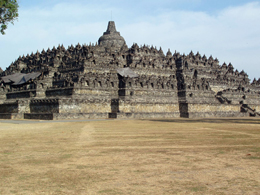
The region is probably best known for its wealth of Buddhist and Hindu temples, most notably Borobudur – the world's largest (and many would argue most beautiful) Buddhist temple, which is decorated with 2,672 relief panels and 504 Buddha statues.
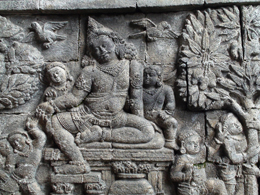
It has been described as an epic scripted in stone and is the single most visited tourist attraction in Indonesia, constructed in eight layers - the first five of which are square terraces with the sculpted walls showing scenes from Buddhist mythology. The topmost layers are circular and each has a ring of bell-shaped stupas (Buddhist shrines). Pilgrims would walk through some five kilometres of passages and stairways before reaching the summit. The design was meant to depict the structure of the Universe with man's progression through life towards Nirvana.
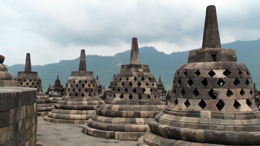
Borobudur dates back to the 8th and 9th centuries, but was abandoned following the fourteenth century decline of Buddhist and Hindu kingdoms in Java and the subsequent conversion to Islam. It lay hidden for centuries under layers of volcanic ash and jungle growth until in 1814, Sir Thomas Stamford Raffles, the then British ruler of Java, was advised of its location by native Indonesians. Since then the temple has been preserved through several restorations, the largest undertaken between 1975 and 1982 by the Indonesian government and UNESCO, following which the monument was listed as a UNESCO World Heritage Site in 1991.
The other must-see attraction is Prambanan’s Hindu temples – a compound 17 kms east of Yogya which is the biggest temple complex in Java. There are 224 temples altogether, with three on the central terrace at up to 47 metres high dominating the complex. Of particular appeal is the wealth of sculptural detail to be found, of which the most famous is on the inner wall of the balustrade featuring the Ramayana epic. Following the May 2006 earthquake, however, which killed 5,782 people and left over 36,000 injured, many parts of Prambanan are roped off to visitors until they are eventually made safe.
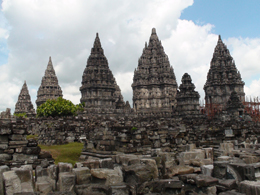
Yogyakarta city itself is known as a centre of classical Javanese fine art and culture with batik, silver work, ballet, drama, music, poetry and Wayang puppet shows much in evidence. Yogyakarta is also known for its gamelan music, which developed in the courts, as well as for being a haven for underground art. It is home to many indie filmmaking communities, indie musicians, performance artists and visual artists.
At the city’s centre is the Kraton, or Sultan's palace - a walled city within a city with luxurious pavilions dating back to the 18th century and in which the current Sultan still resides. It is filled with richly decorated reception buildings, wedding carriages and a vast array of memorabilia documenting the sultan's life.
While the city sprawls in all directions from the Kraton, Jalan Malioboro with its row upon row of street vendors and malls is the primary shopping street for tourists. It is always crowded and is particularly famous for its night street food-culture. Many tourist shops and cheap hotels are concentrated along this street. Here too you can find traditional horse-pulled carts, known as andong, which wait for tourists outside hotspots like the train station and the Kraton. Haggling furiously is expected and you can easily bring the quoted price down to at least half of what is originally demanded.
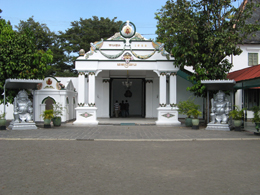
Parangtritis Beach, a seaside resort 27 km south of Yogyakarta on the Indian Ocean, is one of the better known beaches. To get there you travel through breathtaking scenery. The beach – with dark volcanic sand - is surrounded by jungle clinging to the mountains; but its enormous waves and currents are known to be extremely dangerous and many people who have ignored the warning signs have died there. There are, however, many other beaches with white sand which are perfectly safe.
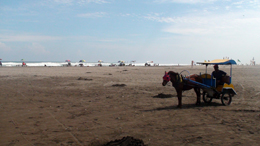
Visitors from the UAE will find that with current exchange rates, they get an enormous mount of Indonesian rupiah to the dirham with the result that prices appear very low. With all its breathtaking scenery, staggeringly beautiful attractions and with so much to do and see, Yogyakarta should surely be on everyone’s must-visit wish list.
